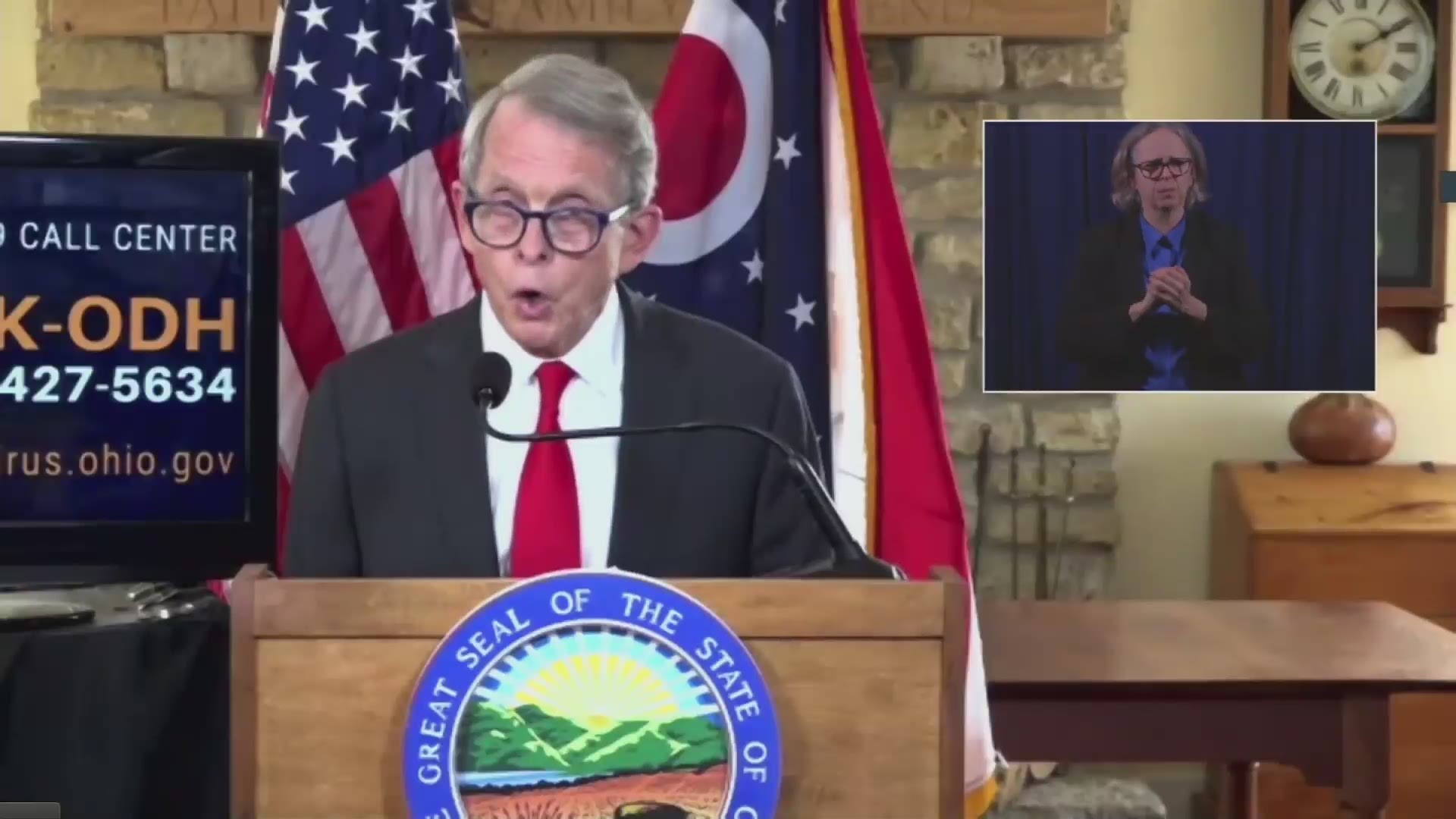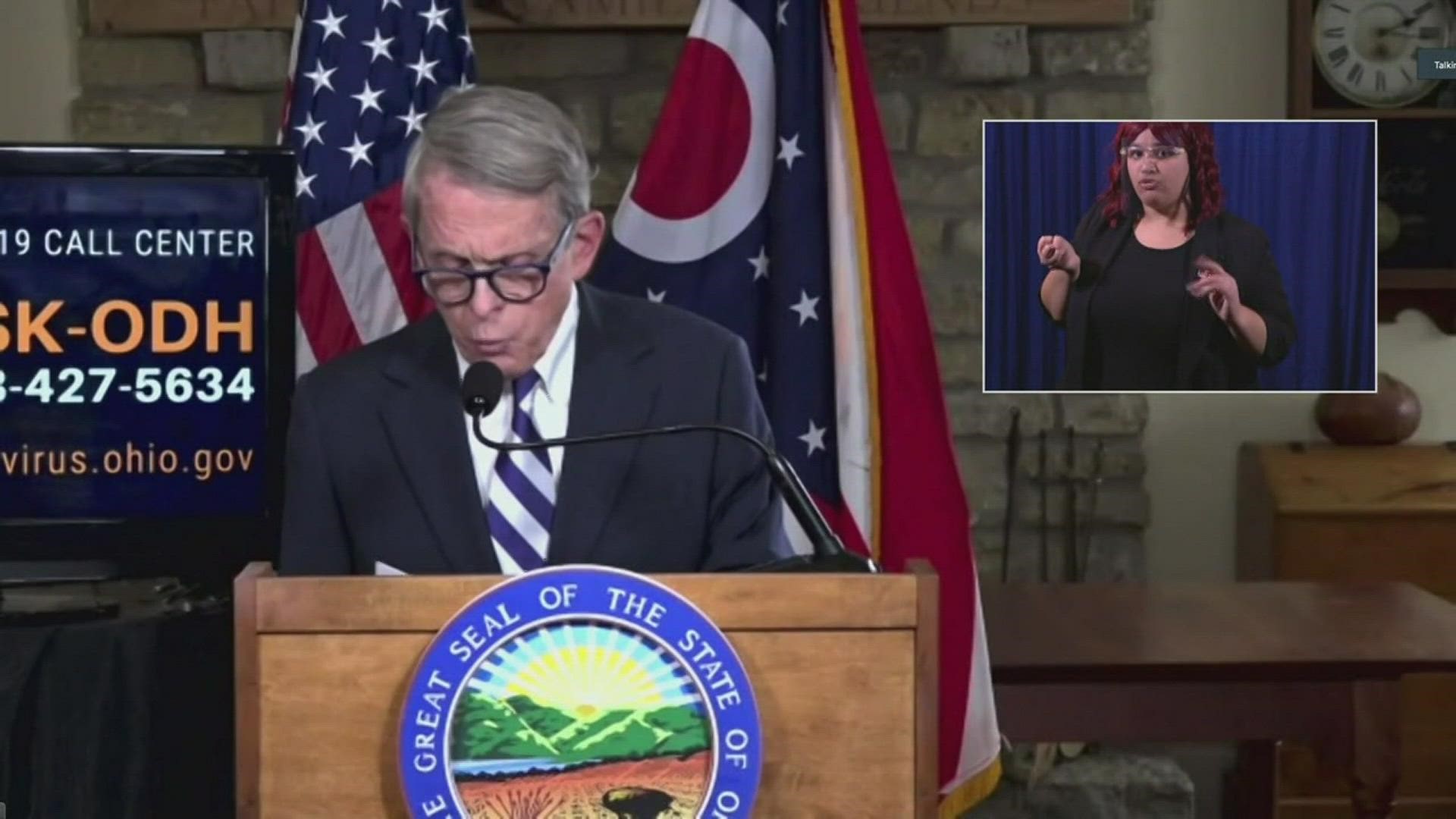COLUMBUS, Ohio — Gov. Mike DeWine unveiled tentative distribution dates for the state's first round of COVID-19 vaccinations Friday, clarifying which Ohioans will be prioritized in receiving the doses.
The governor said he spoke recently with Vice President Mike Pence, who called the process a "work in progress." According to DeWine, the federal government has made clear that state leaders won't know for sure how many vaccines are coming with each shipment until closer to the expected date of their arrival.
However the main objectives, he said, are the same: save lives, slow the spread of COVID-19 and protect healthcare workers on the frontlines.
WHO GETS THE VACCINE FIRST?
DeWine said Phase 1(a) is expected to start mid-December, with the first doses going to:
- Healthcare workers and personnel involved in the care of COVID-19 patients
- EMS responders
- Vulnerable individuals who live together in close proximity and those who care for them, including:
- Residents and staff at nursing homes
- Residents and staff at assisted living facilities
- Patients and staff at state psychiatric hospitals
- People with intellectual disabilities or mental illness who live in group homes along with staff
- Residents and staff at Ohio veterans' homes
PRELIMINARY DISTRIBUTION DATES
DeWine said his team is still waiting on confirmation for what will be sent out in the month of December. He, again, noted that state leaders will not know for sure how many doses are in each batch until a few days before they are sent out.
However, these are the preliminary dates for distribution, along with the expected doses:
- DEC. 15: 9,750 Pfizer doses for Ohio hospitals; 88,725 doses for Walgreens and CVS to be distributed in congregate care settings like nursing homes
- DEC. 22: 201,000 Moderna doses for 98 Ohio hospitals and 108 health departments; 123,000 Pfizer vaccine doses for CVS and Walgrees to be distributed in congregate care settings like nursing homes
- SEVERAL DAYS LATER: 148,000 Pfizer doses; 89,000 Moderna doses
The Pfizer vaccine requires a patient take two doses spread apart. DeWine noted that the state would not be reserving any doses from the first batch for the patients' second round. Instead, they will wait until the next batch of doses are received to get their next round of the shot.
The governor explained that teams will be looking at what areas have the worst spread of the virus, while still trying to spread out the vaccine across the state.
But, while specific groups have prioritizations, how will the state determine which individuals within those defined groups go first?
DeWine said the goal is to balance impact with efficiency. For example, they will try to vaccinate entire nursing home facilities at one time, rather than looking at it from an individual standpoint.
In terms of the general population, it is still too soon to tell when the vaccine will be widely available.
VACCINE SAFETY
Infectious disease specialist with Ohio Health, Dr. Joseph Gastaldo, said that having an effective vaccine and vaccine strategy will be the first step to getting Ohio back to a "pre-covid way of life."
Both the Pfizer and Moderna options are believed to be around 95% effective following preliminary trials.
Gastaldo said that collectively, both trials prioritized safety in the highest scientific testing methods, and have enrolled about 175,000 people from diverse populations.
One Dec. 10, Pfizer will have its FDA review, and its data will be examined by non-government experts.
If it is approved by the FDA, the data will then go to another group of independent experts through the Centers for Disease Control and Prevention (CDC) Advisory Committee for Immunization Practices.
Both of these review meetings are open to the public.
After the vaccine is both approved by the FDA and recommended by the CDC it will be available for people to receive.
Many Americans have expressed concern over the speed in which the vaccines have been produced. But, Gastaldo said President Donald Trump's Operation Warp speed has provided a more efficient way to get a vaccine out there.
Gastaldo said the way studies are being done for the approval of this vaccine, is exactly the same as it has been done for other vaccines.
"We are doing it in a more efficient way that does not compromise safety," he said.
In terms of side effects, so far, some people have reported a sore arm or maybe a headache. However, Gastaldo said that this is normal.
"When you get a vaccine, you want your immune system to be stimulated," he said.
Gastaldo claimed that it isn't abnormal to feel a bit off-kilter for a day or so after receiving a vaccine.
"When a COVID vaccine is FDA approved and CDC recommended I will be rolling up my sleeve hopefully sometime in the near future, Gastaldo said.
SHORTENED QUARANTINE GUIDELINES
Ohio Department of Health Chief Medical officer Dr. Bruce Vanderhoff said Friday that quarantining after COVID-19 exposure is vital to thwarting the spread of the virus.
After lengthy study of the virus' incubation period, and in an effort to increase compliance, the CDC and ODH have made adjustments to quarantine guidance.
While the 14-day recommendation is still the safest option, and is encouraged for those living in highly-populated settings, the CDC now recommends the following after exposure, under the condition no symptoms are present:
- With no COVID-19 test, quarantine for 10 days after exposure
- With a negative COVID-19 test result, quarantine for seven days after exposure.
Vanderhoff explained that the adjustment should help relieve some of the burden placed on Ohioans, as a 14-day quarantine can cause struggles, financially, socially and mentally. However, no matter which option someone chooses, they should monitor themselves for symptoms for the full 14 days, and if they do get sick, they should stay home and self-isolate in a room away from others.
KEY INDICATORS
On Friday, the Ohio Department of Health (ODH) reported:
- 10,114 new cases compared to the 21-day average of 8,306
- 129 deaths compared to the 21-day average of 56
- 392 new hospitalizations compared to the 21-day average of 325
- 33 new ICU admissions compared to the 21-day average of 33
DeWine said Friday brought the third-highest 24-hour increase in reported deaths and the fourth-highest 24-hour increase in cases.
However, it is important to note that ODH data is still incomplete in terms of reporting new cases. There is a backlog of thousands of antigen rapid tests that are left to review. DeWine said earlier this week that the department should be caught back up in around 10 days.


As cases continue to surge across the state, DeWine said that he believes some of the measures put into place - like the mask mandate and 10 p.m. curfew - have helped, but not enough.
"We're gonna have to do more. We don't have any choice," he said.
FULL PRESS CONFERENCE
THURSDAY
The state has yet to see the effects Thanksgiving gatherings may have on the COVID-19 pandemic, but leaders at state hospitals are already concerned about waning capacity.
DeWine said that as of Thursday, there were 5,142 patients currently hospitalized, with 1,204 of those patients in the ICU.
Dr. Andy Thomas with the Ohio State University Wexner Medical Center said that many hospitals around the state have been able to slightly increase capacity for routine beds, but noted that the hardest area to increase beds is in ICU.
Thomas explained that in order for the ICU to function, it needs very specialized staff, nurses and doctors and specially-trained respiratory therapists, to a level where they can manage patient's oxygen.
One out of every three people in ICU has COVID-19, Thomas said. If that number grows, those patients will begin to crowd out non-COVID-19 patients.
In the rural regions of the state, Thomas said that more than one out of every two patients are fighting coronavirus.
"That's not sustainable for those hospitals to be able to manage," he said.
Some hospitals are already making difficult decisions to delay certain types of care.
Dr. Nora Colburn, Associate Medical Director for Clinical Epidemiology at the Wexner Medical Center acknowledged that people need the types of surgeries and procedures that are being delayed, but noted that facilities are left without options.
"It is not good to delay healthcare like this, but hospitals are filling up," she said.
Colburn described a worsening strain on both staff and resources.
"We're in crisis. Hospitals across the state are running out of beds. Staff is burnt out," she said.
Thomas said that the current spike has nothing to do with the Thanksgiving holiday. There still hasn't been enough time to feel those impacts. People are just now getting tested from the holiday, and in general, it takes about a week after symptoms begin for a person to be hospitalized; ICU admissions generally happen a week after that.
With the holidays around the corner, Thomas said that the state is just now heading into the most challenging three months of this pandemic.
"This is not the beginning of the end, this isn't even the end of the beginning," he said.
One Stark County facility was reported to have used a refrigeration truck after it reached capacity in its morgue. DeWine called it a "stark, gut-wrenching reminder of what's at stake."
KEY INDICATORS
On Thursday, the Ohio Department of Health reported:
- 8,921 new cases of coronavirus compared to the 21-day average of 8,209
- 82 deaths compared to the 21-day average of 52
- 396 new hospitalizations compared to the 21-day average of 320
- 33 new ICU admissions compared to the 21-day average of 32

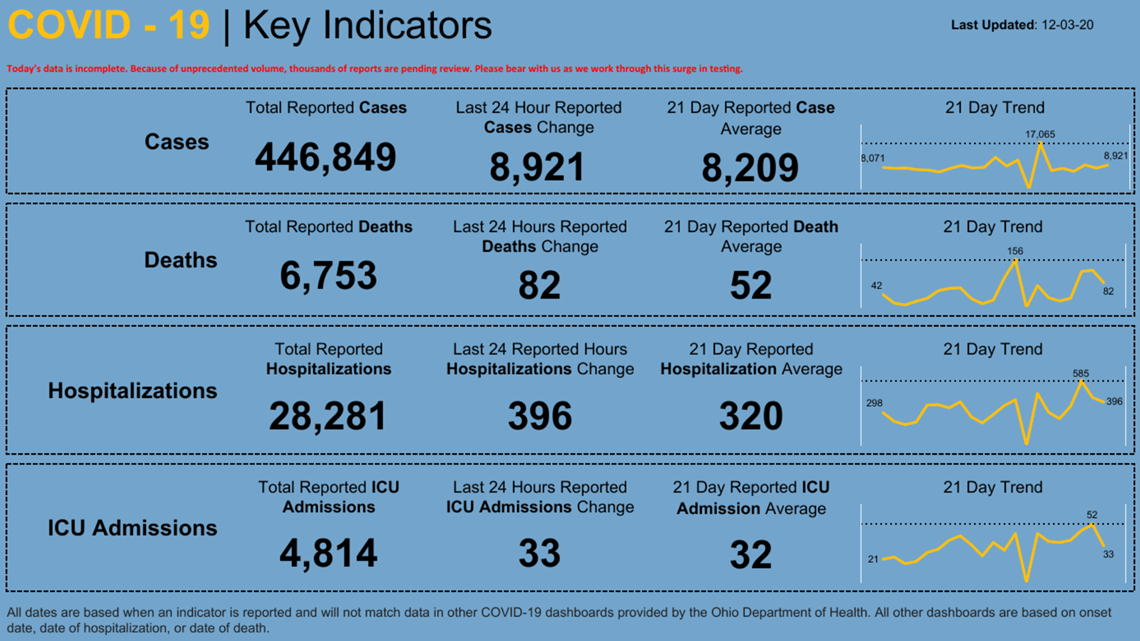
POSITIVITY RATE
For the first time, Ohio has surpassed a 15% positivity rate in COVID-19 testing, which is the threshold for the state's own travel advisory.
"Now we are one of those states we've been warning people about," DeWine said.
DeWine said that the milestone brings with it recommendations to stay at home except for necessary trips and supplies, to wear a mask consistently and frequently wash hands.
Chief Medical Officer with the Ohio Department of Health (ODH) Dr. Bruce Vanderhoff said that rates between 10% - 15% have been described as a "thunderstorm." However, rates rising above 15% have been associated with a tornado.
Vanderhoff said that Ohioans shouldn't despair, but the positivity rate should serve as a "wake-up call."
"Remember, this virus spreads from me to you when we are near each other. For a little while, we need to stay apart. And that really means that we have to stay home," he said.
BEST PRACTICES MOVING FORWARD
Colburn urged Ohioans to take the following steps to combat further spread of the virus:
- Stay at home except for essentials
- Wear a mask every time you are in public and around others - both indoors and outdoors
- Work from home if possible
- Don't eat and drink with anyone outside of your household
- Don't attend private gatherings at someone else's home
- Don't participate in holiday gatherings with people from outside of your household
- Wash hands frequently
- Don't touch your face
Colburn said she believes people think they are keeping their social circles small However, they aren't taking into account the people those friends are in contact with.
"I think a lot of people think they are being safe, but in reality, their social circle is a lot bigger and more dangerous than what it should be," she said.
PUBLIC HEALTH ADVISORY MAP
Wood County moved off of the watch list Thursday after the governor placed it there last week. And despite predictions made by local health officials, Lucas County stayed off of the watch list for yet another week.
However, as northwest Ohio counties stayed out of Level 4 (Purple), the number of counties to meet that threshold grew again on Thursday, with eight moved to the highest level on the map.
While the map will continue to be updated, DeWine said it is less relevant than it was in the beginning of the pandemic.
Instead, he said, the most valuable tools for understanding the current situation are hospital utilization and his list of counties in order of those with the most cases per 100,000 people to the least. The list, he said, gives you an indication of what community spread is like now, and what your odds are of running into someone with the virus while out in public.
VACCINE
DeWine plans to layout the vaccine distribution plan on Friday, along with detailed information on how many doses the state is expected to receive.
He said more information continues to come in, but he expects Ohio to get 98,000+ doses of Pfizer's vaccine in the first week.
MONDAY
Concern continued to grow for Ohio hospitals, as more staff fell ill and beds were filled due to the surging COVID-19 pandemic.
Chief Clinical Officer for The Ohio State University Wexner Medical Center Dr. Andy Thomas reported that state hospitals had crossed 5,000 inpatients with COVID-19 for the first time. He said that back on Nov. 1, there were just under 1,700 patients in the state, meaning the state has seen a 200% increase in the last 30 days.
Thomas said health leaders had specific concerns surrounding ICU capacity, as the state's healthcare facilities worried about their ability to manage the growing number of patients.
"One of every three people on a ventilator has COVID. They'll crowd out other people who need that care if the numbers continue to rise," Thomas said.
Thomas explained that hospitals had begun to face difficult decisions about delaying care, as they can't afford to have their ICUs overtaxed.
One hospital in the northern part of the state, he said, had to call in a refrigeration truck because it had exceeded the capacity of its onsite morgue.
"I'm asking every Ohioan to continue to pull back and limit your activities. There is a cause and effect to what we do - we can slow this down. The scariest thing is that there is no indication that we have plateaued. We haven't seen anything like this for 100 years," DeWine said.
KEY INDICATORS
Here's a look at the coronavirus data reported by the Ohio Department of Health Monday:
- 6,631 new cases compared to the 21-day average of 7,909
- 30 deaths compared to the 21-day average of 43
- 357 hospitalizations compared to the 21-day average of 296
- 38 new ICU admissions compared to the 21-day average of 30

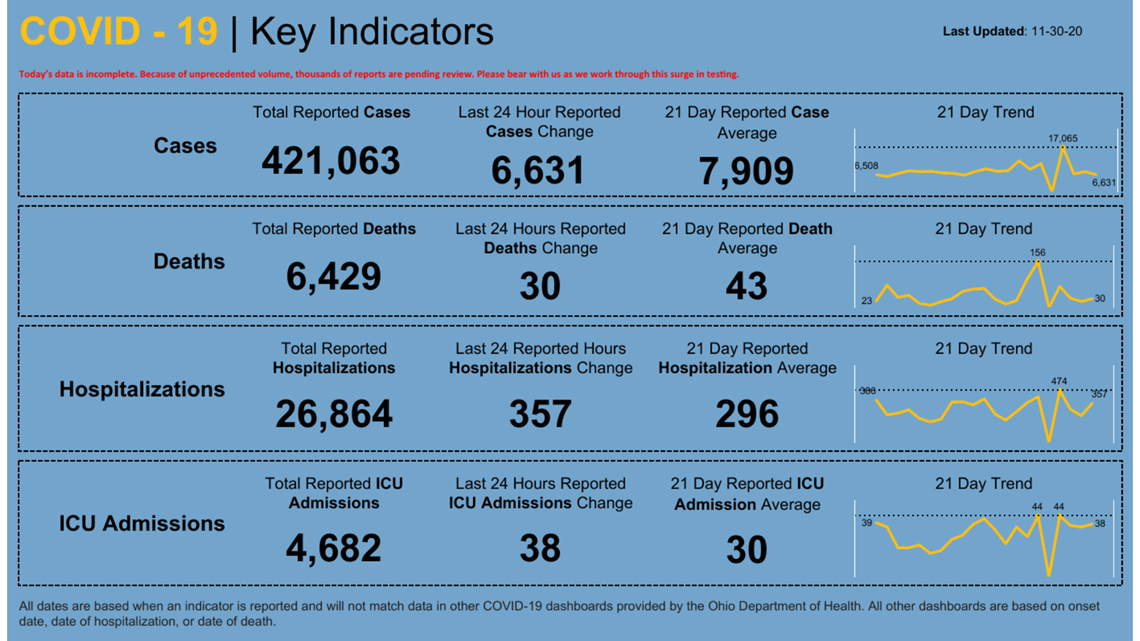
It should be noted, however, that the data Monday remained incomplete. According to the health department, there were still thousands of reports pending review.
DeWine said that the backlog does continue to grow, but the health department is expected to switch over to a new reporting system in the coming days. He explained that once that does happen, there will be a one-day reporting surge, which will catch everything back up.
The governor did report, however, that on Monday there were 5,060 people in Ohio hospitals with COVID-19. Of those patients, 1,180 were in the ICU.
CASES PER 100,000
All Ohio counties exceeded the Centers for Disease Control and Prevention's threshold for high incidence of spread, which is 100 cases per 100,000 people. In fact, the county with the lowest incidence of spread, was still reported at 3.5 times that threshold.
In northwest Ohio, however, only Paulding was on the list's top 20, dropping down to the sixteenth spot with 851.5 cases per 100,000 people - still more than 8.5 times the CDC threshold.

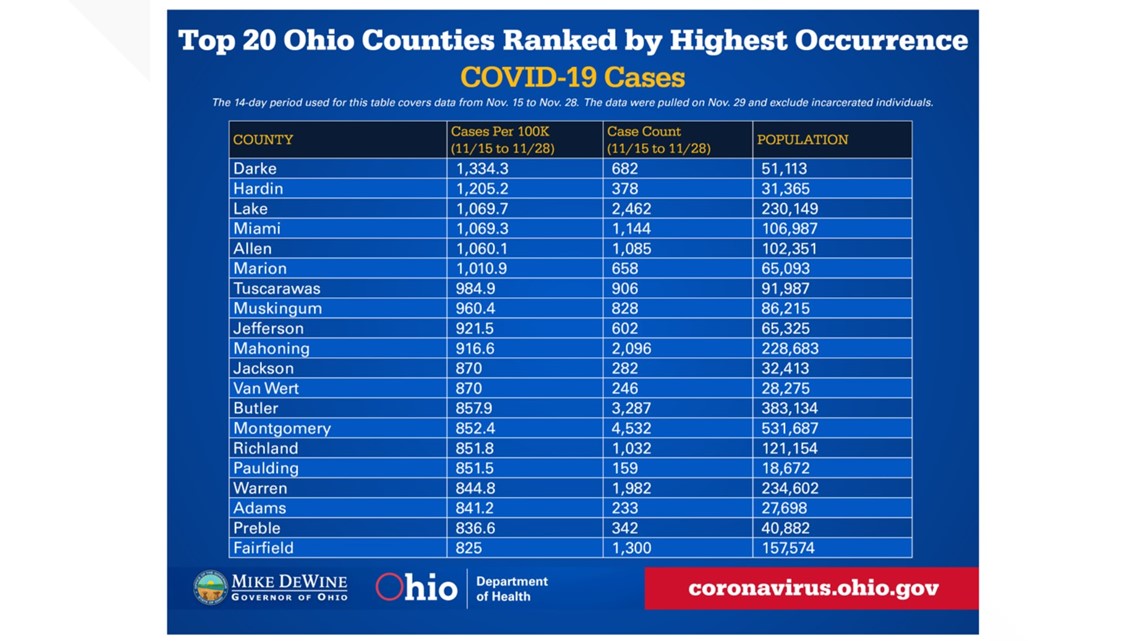
NURSE'S PERSPECTIVE
Three medical professionals shared their experiences during Monday's press conference, including:
- Stacey Morris, a nurse manager for one of the COVID units at Cleveland Clinic Akron General
- Carrie Watkins, the assistant director for nursing at Genacross Lutheran Services in Holland
- Dara Pence, an ICU Nurse Manager at Riverside Hospital in Columbus
- Jamie Giere, a nurse and team leader for the COVID Unit at Premier Health’s Upper Valley Medical Center in Troy, north of Dayton.
Morris said that nurses and doctors were stretched thin. There aren't teams of nurses and respiratory therapists waiting in the wings, she explained. Most of them have been working through this since March.
"This isn't a hoax. This is our reality," Morris said.
Morris pleaded with Ohioans to take their role in stopping the spread seriously, as the virus continues to surge throughout the state.
"While it has been coming in waves, this is one of the biggest waves we've ever seen and we don't see an end to the growth. And we're hoping that we can come together as a state and a country to help slow this. We need to slow it like we did before and unfortunately, we can't do that without the help of everybody," Morris said.
In long-term care facilities, specifically in northwest Ohio, Watkins said that she had seen such a high rise in cases throughout the community, that the virus had gotten in and taken over her facilities. She said that no matter how much they prepare and work to control the spread, the virus still manages to get in.
"I hope people can understand that their actions can have unintended consequences. Even if you don't have a loved one in a nursing facility, you could start a chain reaction that brings the virus in. These lives are worth protecting," Watkins said.
Pence painted a similarly grim picture of the state's ICUs. She said that while some people assume young people are unaffected by the virus, that isn't always the case.
"COVID is unpredictable, it's throwing curveballs. We're seeing young, healthy people come to the hospital, they're getting sick, and they're passing. The virus can impact anyone from any background," she said.
Pence said that when she asks patients where they think they got COVID-19, she often hears graduation parties, baby showers, funerals, weddings and several people have told her, "I had a mask, but I put it in my pocket when I saw others didn't have a mask."
She called the unit "lonely," as patients are completely isolated. They use Zoom, Pence explained, but called it "very scary" as often it is the last connection loved ones have with their family members.
"I wish we could bring people here with us and have them walk through our unit - but at the same time, I don't want anyone to see what we have seen. We are at war with this disease. If the community can come together and stay safe - that will help get us through," she said.
Giere expressed a similar sentiment, saying she wishes she could show people what her team goes through each day.
"I wish I could wear a go-pro for a few hours of the day for people to realize the stress that healthcare workers go through every day. It's exhausting. It's emotional. I don't think the public truly understands what we go through. Seeing the fear in patients' faces," she said.
You can watch their full interview in the player below.
VACCINE UPDATE
DeWine said he was part of a call with Vice President Mike Pence and other governors regarding COVID-19 Monday morning.
On that call, infectious disease expert Dr. Anthony Fauci referred to the potential new vaccine as an "extraordinary occurrence.
DeWine said should both vaccines get approved, the Pfizer option could be shipped to Ohio as early as Dec. 15 and Moderna's as early as Dec. 22.
Ohioans can expect a full report on the vaccine distribution plan during Thursday's scheduled press conference.
AIR QUALITY IN LONG-TERM CARE FACILITIES
DeWine announced the creation of a new program to help improve indoor air quality and reduce the transmission of COVID-19 for residents in nursing homes, assisted living centers and adult day centers.
Eligible recipients will be able to receive up to $15,000 to address indoor air quality through HVAC inspections, portable air filtration systems, new filtration systems, maintenance on current systems, and other interventions.
For more information about the program, click here.

